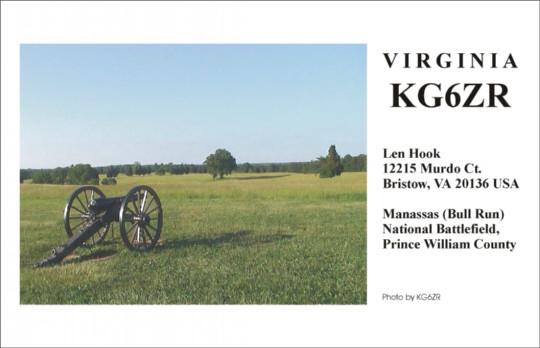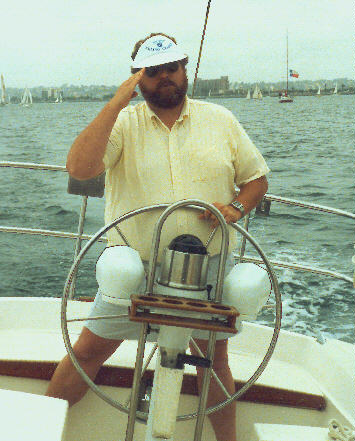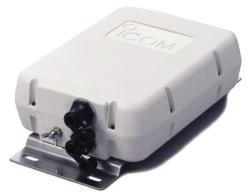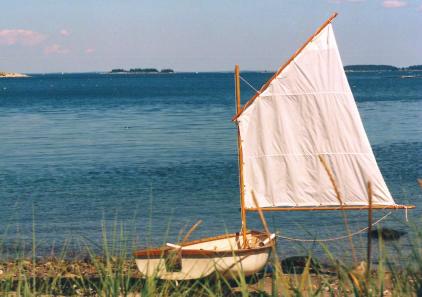
Len Hook, KG6ZR
Bristow, Virginia
“Transmitto Ergo Sum”
I am a microbiologist and have worked in the lab instrumentation field
for 22 years. I was first licensed in 1964 as WN8KYH in Michigan, and quickly
upgraded to General with the call WA8KYH. I held this call for several years
and remained fairly active on the ham bands until the mid-1970s. I was mostly
off the air from 1975-85, but re-kindled my interest in the hobby when I moved
to San Diego and received the current 6-land call.
My favorite mode is CW and I enjoy chasing DX and entering an occasional contest. I especially enjoy operating Field Day on 40-meter CW with the Vienna Wireless Society at Burke Lake Park. I also operate in the digital modes using MixW software and a RigExpert interface.

"Cap'n" Hook, former denizen of San Diego Bay
Amateur Radio Club Affiliations
Vienna Wireless
Society, Vienna, VA, K4HTA, K4XY
www.viennawireless.org/home.php
QCWA Quarter Century Wireless Association
Vic Clark Chapter 91, Washington DC
http://homepage.mac.com/rrucker/chapter91/
Other Interests
Sailing, golf, 1962 Corvettes, collecting coins, and golden-oldies of the 60s
The KG6ZR Ham Shack
ICOM IC-756 Pro II
ICOM IC-706 MkII
ICOM AH-4 Auto-tuner
Kenwood TS-940S, MFJ-949E Tuner
Kenwood TR-751A All Mode 2-m Xcvr
AEA PK-232 Pakratt TNC
RIGblaster PSK31 / RTTY Interface
Len's "Antenna Farm in the Attic"
HF Antenna No. 1. 80 - 10 Meter Bands. 180-foot folded dipole tuned with ICOM
AH-4 Auto-tuner at the feed-point. “Counterpoise” is 30-m (100 ft.) heavy gauge
stranded copper cable fed into the basement.
HF Antenna No. 2. 20 - 10 Meter Bands. AEA IsoLoop with Autotuner VHF / UHF Antenna No. 1. 144/440 MHz. Cushcraft A270-10S, 10 el. beam
VHF / UHF Antenna No. 2. 144/440 MHz. Diamond X-50A Dual Band Vertical
The Ultimate Stealth Antenna
I am one of those 'antenna-challenged' radio amateurs who dreams of the day
when I can erect a 70-foot tower in my backyard, and install a 6-element
tri-band beam on top. But in my deed-restricted community all outdoor ham
antennas are verboten, so I've made the maximum use of the attic to
install a hidden antenna farm. My newest indoor HF antenna, an 180-ft. folded-dipole
“loop” tuned by the ICOM AH-4 auto-tuner, has proved to be the most efficient
of the ones I’ve tried.

I've been using the ICOM IC-706 MkII transceiver for a few years, and have been quite pleased with it, so when I decided to investigate the purchase of an automatic tuner, I naturally gravitated to the ICOM AH-4. After surfing the web for information and comments, I convinced myself that this was the correct unit for my plans, and marched down to the local HRO and bought one. It's one of the smartest moves I've made. I've become a real 'fan' of this little device, and recommend it highly. It is designed to interface directly with ICOM radios, and is activated simply by pushing the Tuner/Call button on the front panel of the IC-706 MkII. AA7LO reports that the unit can be connected to any transceiver, and his web site offers a schematic diagram of the connection (http://www.geocities.com/aa7ol/aa7ol/Icom_ah_4_ah_3.html), however, I haven't tried it.
Once the new antenna was installed, I decided to test it by operating informally in the North America CW QSO Party. In a 10-hr period I managed to work 41 states (from ME to HI) and 11 countries. Since then I've confirmed 135 countries, and have no difficulty working DX. The antenna loads on all bands, from 80 to 10 meters, and I've operated them all successfully (CW and SSB). If you are seeking a solution for your own 'ultimate stealth' indoor antenna, I can recommend the following construction.
The antenna is technically a folded dipole with a “loop” of 16-gauge bare copper stranded wire measuring approximately 30 x 15 feet connected to the “hot” side of the AH-4 auto-tuner. I tried to string up as much wire as my attic would allow. Both ends of the “loop” terminate at the top feed point on the AH-4. The wire is supported by ten, 1-ft. pieces of PVC pipe that are mounted on rafters in the attic and serve as stand-offs for the antenna. The stand-offs are made by cutting a 10-ft, 1/2 inch diameter PVC pipe (from your friendly Home Depot) into 1-ft. lengths. Each piece has a hole drilled at one end, cross-wise, so you can feed the wire through it. I mounted each stand-off by gluing it into a 1/2 inch PVC pipe cap screwed into the appropriate rafter in the attic. The antenna doesn't sag or touch anything but PVC pipe.
The “counterpoise,” attached to the ground connector on the bottom of the AH-4, consists of 100 feet of heavy gauge bare copper stranded cable. I don't know the exact gauge, but it is about 1/4 inch diameter (Home Depot supplies it). The cable extends away from the “loop” and then is directed down into the basement, where it terminates. It is not connected to an earth ground.
The trick to installing this attic antenna is feeding the coax, counterpoise, and 4-conductor control cable from the AH-4 down to the rig. My house has a "chase" with a built-in 3-inch conduit to feed the wires down from the attic. I'm sure there are many other ways to do this. I am indebted to my good friend, Phil Kinningham, who helped me with all the antenna installations. He surely holds the record for most antennas strung by a non-ham.

My Favorite Place on Earth
Penobscot Bay. Spruce Head, Maine.